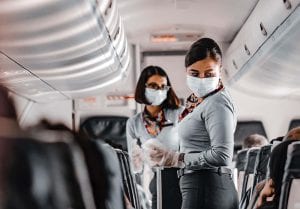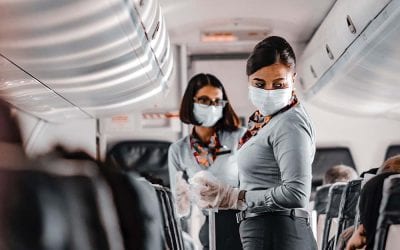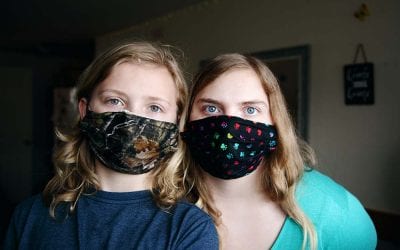It’s time to debunk four COVID-19 face mask myths that have resurfaced that, unfortunately, too many air travelers believe.
 Last week, I wrote about the surge of COVID-19 cases hitting the U.S. and across the globe this summer. I discussed protective measures for travelers to prevent serious COVID infection for themselves, family and friends. Today we deal with face mask myths.
Last week, I wrote about the surge of COVID-19 cases hitting the U.S. and across the globe this summer. I discussed protective measures for travelers to prevent serious COVID infection for themselves, family and friends. Today we deal with face mask myths.
Since “A summer COVID wave is hitting hard — do we need to mask-up now?” was published, I’ve received many emails asking me about passengers’ masking conduct on flights in the U.S. and Europe.
Travelers United readers have commented that they see many air travelers in airports and planes who don’t understand how to use face masks for COVID protection.
Readers wrote to me about air travelers wearing their face masks below their nose and pulling them down every time they spoke. Others asked about surgical versus N-95 and KN-95 masks. Still others asked about wearing a mask even though they were fully vaccinated.
This week, it’s time to discuss COVID face mask myths that have resurfaced.
 Myth 1: It doesn’t matter if your mask covers your nose.
Myth 1: It doesn’t matter if your mask covers your nose.
Frankly, leaving your nose uncovered while wearing a face mask for COVID-19 protection totally defeats the purpose of wearing the mask. Yes, particularly if it’s an N-95 or KN-95 mask, it’s more difficult to breathe through a face mask than if you weren’t wearing one. So yes, it’s easier to breathe while wearing a mask with your nose uncovered, but if it’s uncovered, commonsense will tell you that you’ll primarily breathe through your uncovered nose, not your filtered mouth. That turns your face mask into worthless fabric.
A study published in the journal Cell, mapped locations in the respiratory tract where the COVID-19 virus most quickly invades, multiplies and spreads. The study found that the cells that line the nose were significantly more likely to become infected, as well as shed virus, compared to the throat or lungs. Therefore, while it’s somewhat of an overstatement, some could say that by wearing a mask that covers your mouth, but leaves your nose uncovered, it’s possible you’d be better off not wearing a mask at all.
If you don’t cover your mouth and nose with your face mask, you might as well not wear the mask at all.
For those who are already infected with COVID-19 and covering their mouth with their mask, but not their nose, every time they exhale through their nose they are generally expelling out a higher concentration of infected respiratory droplets and aerosols than if they were exhaling from their mouth, or split between their mouth and nose.
For those who aren’t yet infected with COVID-19 and covering their mouth, but not their nose with their mask, every time they inhale through their nose, if there are COVID-19 infectious aerosols in the air, they’re pulling it into the most vulnerable place in their respiratory tract to become infected with COVID-19.
Therefore, there’s no doubt among physicians and public health officials that when you wear a face mask to protect others from your COVID-19 infection or to protect yourself from becoming infected, make sure it fits properly and covers both your mouth and nose.
Myth 2: It doesn’t matter if you pull down your mask to speak.
Commonsense tells us that anytime we pull down our face mask, we open ourselves to infect others if we’re already sick, or to become infected from those around us who are already infected.
We know that COVID-19 spreads via both respiratory droplets and aerosols. Studies have shown that when an infected person without wearing a face mask speaks, they spread the COVID virus. The respiratory droplets expelled when we speak are generally the intermediate size that stays suspended in the air for at least several minutes when we’re inside. As the droplets evaporate while suspended, they aerosolize, allowing them to stay in the air and move around for quite some time.
When you pull down your mask to speak you’re negating its protection at the very time you need it the most.
Adding to the danger that speaking without a mask while infected holds, COVID-19 infections tend to start in the upper respiratory tract. That’s precisely where respiratory droplets that our mouth expels during speech are formed.
Conversely, for those who are uninfected, each time you drop your mask in order to have a conversation, particularly when close to others, which in an airport and airplane is likely, you’re opening yourself to directly breathing in the infectious respiratory droplets and aerosols spewing out of the mouth of those with whom you’re speaking, if they’re already infected with COVID.
Myth 3: Surgical masks are as good as KN-95 and N-95 masks to protect you from COVID-19:
There’s no doubt that wearing a surgical mask, the disposable masks that are often blue with white borders and elastic ear loops, are better than not wearing a mask at all. Surgical masks will protect against the large respiratory droplets that come from sick people when they cough or sneeze. That said, they’re far too loose with a composition not capable of protecting against many germs, including COVID, that are floating on aerosols in the air.
Surgical masks aren’t as good as N-95 and KN-95 masks to prevent COVID transmission.
KN-95 and N-95 masks fit tightly around your face, covering both your nose and mouth with a filter material that filters out at least 95 percent of the smallest infectious droplets and aerosols. N-95 face masks are superior to KN-95 face masks because they’re held on to the face better to give a better and more consistent tight fit to the face. Even so, because of the fit and filter material, both KN-95 and N-95 face masks are considerably superior to surgical masks.
Myth 4: It’s unnecessary to wear a face mask if you’re fully vaccinated for COVID-19:
Both the Centers for Disease Control and Prevention (CDC) and the World Health Organization (WHO) are clear that regardless of being fully vaccinated, anyone in areas where the number of COVID-19 cases is elevated should wear face masks to protect themselves.
After billions of doses of COVID vaccines have been injected into people, the reality is that we know that the vaccines are safe and effective. Some people have had side effects, but they are usually mild or moderate. There have been some rare serious side effects, according to the CDC, but they appear to be able to be resolved with rest and treatment.
COVID vaccines are safe and provide their promised protection against severe COVID and death.
The COVID vaccines are designed to provide sustained protection against severe COVID disease and death. They are effective at doing that. The vaccines may also prevent infection soon after being administered, however, according to the CDC, that protection is generally modest and not long lived.

The conclusion is clear. Last week, I explained that it’s smart to be vaccinated against COVID-19. That said, whether or not you’re fully vaccinated, wear an N-95 or KN-95 face mask in airports and planes to prevent contracting COVID to the extent possible in areas with elevated COVID cases like we are experiencing at this time in the U.S. Wear the face mask over your mouth and nose. Don’t pull your face mask down to speak. People can easily hear you through the mask.
READ ALSO:
Which hotel amenities do you really want?
The complete guide to EC 261 and European air travel rights in 2024\
After many years working in corporate America as a chemical engineer, executive and eventually CFO of a multinational manufacturer, Ned founded a tech consulting company and later restarted NSL Photography, his photography business. Before entering the corporate world, Ned worked as a Public Health Engineer for the Philadelphia Department of Public Health. As a well known corporate, travel and wildlife photographer, Ned travels the world writing about travel and photography, as well as running photography workshops, seminars and photowalks. Visit Ned’s Photography Blog and Galleries.


